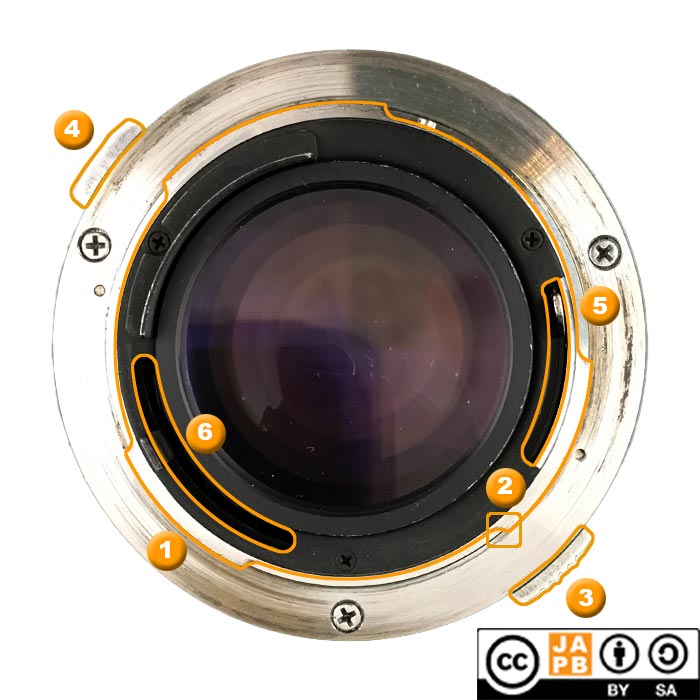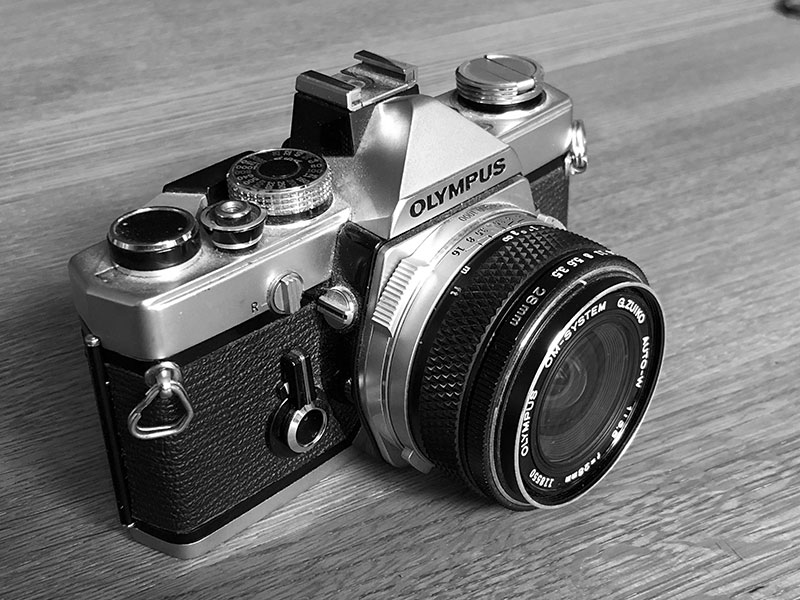Pekka Buttler (updated 5/2025)
Olympus OM mount specifications and identification
Mount type: Bayonet (lens release on lens)
Flange focal distance: 46,00 mm
Film format: 36mm x 24mm (‘Full frame’)
Mount communication: Aperture stop-down (camera-to-lens); Selected aperture (lens-to-camera)

[1] Three-pronged bayonet mount, with tapered prongs.
[2] Locking pin (hidden beneath prong, here) at 4:30 o’clock.
[3] Lens release button. Operates locking pin [2].
[4] Aperture stop-down button (for depth-of-field preview). Pressing of button moves lever [5].
[5] Aperture stop-down lever.
[6] Aperture indicator lever (moves with aperture ring)
Basic Information on the Olympus OM mount:
The Olympus OM-system was introduced in 1972, making it a relatively late addition to the family of Japanese SLR mounts. Then again, maybe that late entry allowed Olympus learn from its competitors’ mistakes, because the OM-system (bodies, lenses, accessories) was highly successful.
While Olympus admittedly left its entry into the SLR market quite late, Olympus was in no ways new to the photography business. Also, entering a somewhat established market allowed Olympus to define a profile and market segment for themselves.
It seems, that from the very beginning Olympus aimed for simplicity, aesthetics and compactness. Olympus camera bodies have always been on the svelte side, and Olympus’ lenses typically are among the smallest and lightest in their respective classes. See the size comparison of equal spec – similar era lenses below.

Right: Nikkor 28 mm f/2

Right: Nikkor Ai 35 f/2.8
The user interfaces (for both cameras and lenses) are well thought-out and elegant. Olympus’ choice of situating the aperture ring at the lens front was sensible as the shutter speed selection was done on the camera-end of the lens mount (see below). Workmanship and materials are likewise of high quality. Furthermore, the lenses look darn nice.

All shooting controls (aperture, shutter speed, focus) are situated on the lens (big dial on top is for ISO selection).
It also is clear, that the OM system was not just a stab at entering the SLR-market. Olympus made a dedicated effort and seems to have had an ambitious product roadmap from the get-go. Merely in the year 1972 (the year of the launch of the OM-1 and the OM line), Olympus introduced 27 (!) lenses, including two fisheyes (8/2.8 and 16/3.5), one shift lens (35/2.8), two macro lenses (50/3.5 and 80/4), one tele zoom (75-150/4) and 21 primes (ranging from 18 mm to 1000 mm), including a full range of large-aperture primes (24/2, 28/2, 35/2, 50/1.4, 55/1.2, 85/2).
The roster of Olympus OM lenses is just as comprehensive as that of their main rivals, interspersed with some fantastic feats of optical engineering. The first decade of the OM system was a veritable parade of success and achievement, rained on only by Leica (which demanded that Olympus change the system’s name 1)
Given the popularity of the OM system, third-party manufacturers also offered their lenses for the OM system, but my totally unscientific, gut feeling is that they never reached a major market share. Considering the traits which attracted users to the OM system (simplicity, quality, aesthetics, compactness) and how these typically were been less pronounced in third-party offerings, this is maybe not surprising.
Demise into a niche product
While Olympus had a winning recipe on their hands with their OM-line of cameras and lenses, by the mid-80’s it was clear that man-in-the-street photographers wanted autofocus. And just as the competition (Minolta, Canon, Nikon, Pentax) also Olympus wanted a slice of that pie. Problematically, few companies stumbled as badly in the introduction of AF SLR’s as Olympus.
Not only was the Olympus OM-707/77 (Olympus’ 1986 AF SLR) largely seen as not matching Olympus’ previous, high standards (neither in quality, design, nor ergonomics), the AF system was quirky and unreliable (just as all first-flight AF systems), made worse by Olympus’ decision to not to furnish AF lenses with focus rings (if the AF did not deliver, you were up sh** creek without a paddle). Moreover, while you could mount Olympus OM lenses on the new AF body, the metering was seriously handicapped leading to an all-around troublesome experience.
To add insult to injury, instead of rectifying the blatant failings of the OM-707 in a follow-on model, Olympus introduced the OM-101/88 (1988), which – although allowing manual focus, did so on a by-wire approach (using a switch on the camera body) while also doing away with AF altogether – sort of a worst-of-both-worlds implementation. Moreover, while you could use the OM-707’s AF lenses on the OM-101 (without AF), the OM-101’s dedicated PF lenses could not be used on the OM-707.
As a result, Olympus had – in only half a decade – changed from a company sporting one, fully-fledged, beautifully integrated system to a company that clearly did not have a collected technological vision. The OM-707/77 and 101/88 were discontinued in 1991, leaving the OM-4Ti as Olympus’ only film SLR on offer.
As the OM system had some remaining traction among the users who could not care less about autofocus, Olympus subsequently even introduced new offerings into the OM line, but Olympus’ corporate focus had shifted towards compacts and bridge cameras. The OM SLR line was finally discontinued in 2002 – just prior to introduction of the Four Thirds system of dSLR’s.
Adapting Olympus OM lenses
While the Olympus OM system technically remained alive until 2002 as a system for manual focus aficionados, all real emphasis on development of the system ended in the late 80’s. With many former OM system users progressing to other systems in the nineties and naughties, a great number of OM lenses have been available for use on other systems.
Interestingly, and largely thanks to one of the longest flange focal distances in 35 mm SLR systems (46 mm, shorter only than Nikon F and Leica R), Olympus OM lenses have been relatively easily adaptable to other SLR systems (such as Canon EF and others).
Today, Olympus OM lenses can be adapted to almost all digital interchangeable lens cameras (SLR as well as mirrorless), with some limitations: Due to longer flange focal distance of Nikon dSLR’s, these can use OM lenses only together with an adapter with optics. If the camera does not have a full-frame sensor (especially four thirds and micro four thirds systems) can use OM lenses either only with a significant crop factor, or in with a focal reducer.
Most importantly though, once adapted, the central controls of OM lenses (focus ring, aperture ring) work flawlessly. Out of my personal experience: OM lenses are a joy to use on a Sony full-frame mirrorless, and I see no reason why this should not apply equally to other full-frame mirrorless bodies as well.
Adapting Olympus OM AF/PF lenses
There is currently (as of 2022) no sensible way of adapting OM Autofocus/Powerfocus lenses to any dSLR/mirrorless cameras. While the construction of an adapter that drives a screw mount is far from impossible, nor is it especially difficult to construct an adapter that would manipulate the lens’ aperture stop down lever, but it seems that no-one has yet decided to start manufacturing such adapters.
OM Autofocus/Powerfocus lenses can (physically) be mounted on many basic OM adapters (but without locking), but their aperture will be at minimum aperture and their focusing cannot be manipulated.
Identifying the Olympus OM mount
See here for the OM (manual) mount.
See here for the OM (autofocus/powerfocus) mount.
Footnotes:
1 The OM system was originally named the M-system (after the head designer Yoshihisa Maitani), but Leica (producers of the successful M-series of rangefinder cameras) opposed this naming. As Olympus was very much interested in western markets, the system was quickly renamed OM (‘Olympus Maitani’), but early OM-series bodies (M-1) and lenses can be found and are of special interest to collectors)